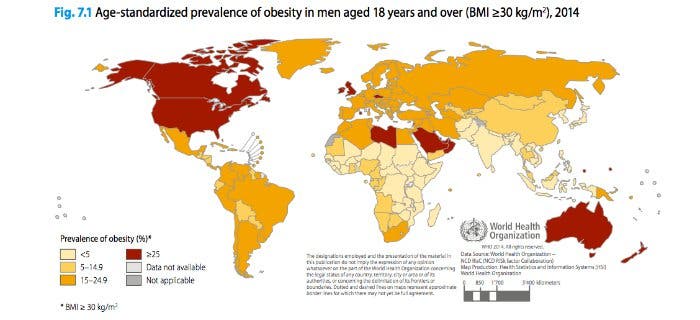It’s painfully true by this point that we have a global obesity problem. Over the past 20 years, obesity rates have more than doubled, now including over a billion adults. The World Health Organization (WHO) has now released its global report card on obesity. See what countries are “in red” below:

The first thing you see on this map is that there’s a lot of red – the US, Canada, Russia, Australia, the UK, northern Africa, the Middle East and most of South America all have very high obesity rates. This is the map for obese women, and red areas have over 25% of adult (over 18) women suffering from obesity.
“Obesity increases the likelihood of diabetes, hypertension, coronary heart disease, stroke and certain types of cancer. Worldwide, the prevalence of obesity has nearly doubled since 1980. In 2014, 11% of men and 15% of women aged 18 years and older were obese. More than 42 million children under the age of 5 years were overweight in 2013. The global prevalence of diabetes in 2014 was estimated to be 9%”, the report reads.
Interestingly enough, men are doing a bit better than women. The WHO released a different map for men – one that’s not as red as the other one.

Overall, the US is doing the worst: an estimated 61 percent of the population is overweight, whereas South-East Asia is at the other end of the spectrum, with only 22 percent of its population overweight. South-East Asia is also one of the poorest areas in the world.
Obesity is technically defined as a medical condition in which excess body fat has accumulated to the extent that it has a negative effect on health. Obesity increases the likelihood of various diseases, particularly heart disease, type 2 diabetes, obstructive sleep apnea, certain types of cancer, and osteoarthritis. Medics are still debating whether or not obesity is a disease, though the stronger arguments seem to suggest that it can’t really be considered a disease, since the causes are rarely medical; most often, obesity sets in as a result of excessive food energy intake and lack of physical activity.
You can read the full report here.


